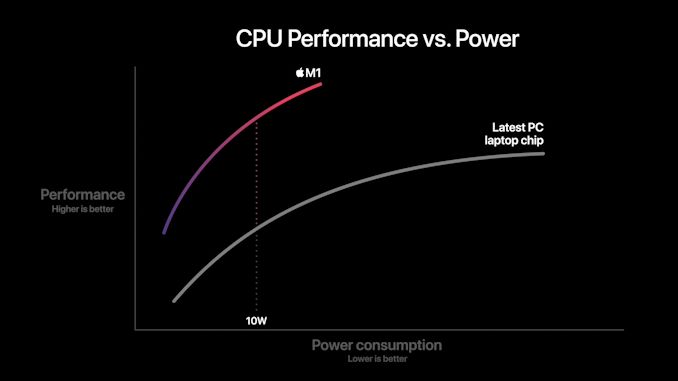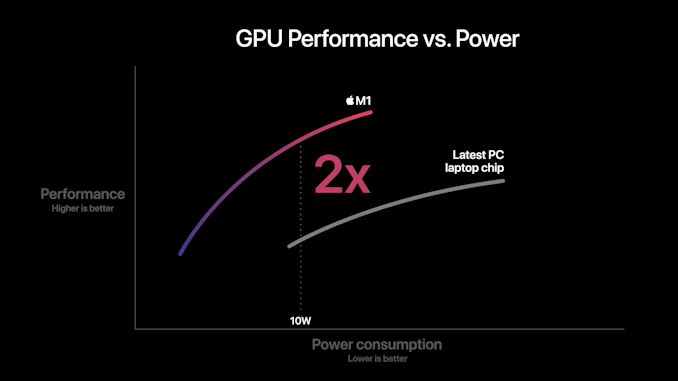Apple Announces The Apple Silicon M1: Ditching x86 - What to Expect, Based on A14
by Andrei Frumusanu on November 10, 2020 3:00 PM EST- Posted in
- Apple
- Apple A14
- Apple Silicon
- Apple M1
Apple Shooting for the Stars: x86 Incumbents Beware
The previous pages were written ahead of Apple officially announcing the new M1 chip. We already saw the A14 performing outstandingly and outperforming the best that Intel has to offer. The new M1 should perform notably above that.
We come back to a few of Apple’s slides during the presentations as to what to expect in terms of performance and efficiency. Particularly the performance/power curves are the most detail that Apple is sharing at this moment in time:
In this graphic, Apple showcases the new M1 chip featuring a CPU power consumption peak of around 18W. The competing PC laptop chip here is peaking at the 35-40W range so certainly these are not single-threaded performance figures, but rather whole-chip multi-threaded performance. We don’t know if this is comparing M1 to an AMD Renoir chip or an Intel ICL or TGL chip, but in both cases the same general verdict applies:
Apple’s usage of a significantly more advanced microarchitecture that offers significant IPC, enabling high performance at low core clocks, allows for significant power efficiency gains versus the incumbent x86 players. The graphic shows that at peak-to-peak, M1 offers around a 40% performance uplift compared to the existing competitive offering, all whilst doing it at 40% of the power consumption.
Apple’s comparison of random performance points is to be criticised, however the 10W measurement point where Apple claims 2.5x the performance does make some sense, as this is the nominal TDP of the chips used in the Intel-based MacBook Air. Again, it’s thanks to the power efficiency characteristics that Apple has been able to achieve in the mobile space that the M1 is promised to showcase such large gains – it certainly matches our A14 data.
Don't forget about the GPU
Today we mostly covered the CPU side of things as that’s where the unprecedented industry shift is happening. However, we shouldn’t forget about the GPU, as the new M1 represents Apple’s first-time introduction of their custom designs into the Mac space.
Apple’s performance and power efficiency claims here are really lacking context as we have no idea what their comparison point is. I won’t try to theorise here as there’s just too many variables at play, and we don’t know enough details.
What we do know is that in the mobile space, Apple is absolutely leading the pack in terms of performance and power efficiency. The last time we tested the A12Z the design was more than able to compete and beat integrated graphics designs. But since then we’ve seen more significant jumps from both AMD and Intel.
Performance Leadership?
Apple claims the M1 to be the fastest CPU in the world. Given our data on the A14, beating all of Intel’s designs, and just falling short of AMD’s newest Zen3 chips – a higher clocked Firestorm above 3GHz, the 50% larger L2 cache, and an unleashed TDP, we can certainly believe Apple and the M1 to be able to achieve that claim.
This moment has been brewing for years now, and the new Apple Silicon is both shocking, but also very much expected. In the coming weeks we’ll be trying to get our hands on the new hardware and verify Apple’s claims.
Intel has stagnated itself out of the market, and has lost a major customer today. AMD has shown lots of progress lately, however it’ll be incredibly hard to catch up to Apple’s power efficiency. If Apple’s performance trajectory continues at this pace, the x86 performance crown might never be regained.












644 Comments
View All Comments
dotjaz - Wednesday, November 11, 2020 - link
They are probably referring to BootCamp.daveedvdv - Thursday, November 12, 2020 - link
Apple has confirmed that Apple Silicon Macs won't support BootCamp anymore.No, they were definitely talking about Rosetta 2. That said, I don't think they said it was a common occurrence. Just that it had been observed on a real application. At least, that's my recollection.
guycoder - Wednesday, November 11, 2020 - link
I suspect a lot of the graphics privatives are translated to running native and are getting an uplift from the new GPU. Sure this is a fast SOC but Rosetta is also converting large parts of any X86 application to the corresponding Apple ARM system library and taking advantage of the extra hardware on the M1. Still all very impressive so far and it's going to be fun to see what having the CPU / GPU / NPU so tightly integrated will bring.valuearb - Tuesday, November 10, 2020 - link
It's running MacOS, which isn't based on iOS. Actually WatchOS is based on iOS is based on MacOS which is based on NextStepOS.Benchmarks have already shown emulated Intel code is running roughly as fast on Apple Silicon as it runs on Intel Macs. These benchmarks came from Developers using the DTK, the ARM based Mac mini Apple gave developers to develop on earlier this year, and it was running a year old iPad processor.!
And PowerPC wasn't better than Intel, especially at the end.
Luminar - Wednesday, November 11, 2020 - link
PowerPC had the advantage of 3DNow! InstructionsZoolook - Wednesday, November 11, 2020 - link
3DNow! was AMD's answer to MMX, was later dropped (mostly) when they licensed SSE.Zoolook - Wednesday, November 11, 2020 - link
Wish we had an edit function, @Luminar maybe you are thinking about Altivec which was the PowerPC SIMD functions, it was indeed poweerful when it was introduced.Ppietra - Wednesday, November 11, 2020 - link
moving the code shouldn’t take that long for many apps. for many it will only need recompile and debugging.Cubesis - Wednesday, November 11, 2020 - link
Um PowerPC was not better than intel... it was way more power hungry. That’s why they switched to Intel in the first place. Even if moving the code did take a long time, (it won’t) Rosetta 2 improvements combined with them being faster than Intel chips, Means that although I can’t wait for everything to be optimized, I don’t really care when everything performs about the same emulated with Rosetta 2 sometimes even outperforming native intel binaries.Cubesis - Wednesday, November 11, 2020 - link
By the way although I understand where you were going with you were admittedly justified criticisms of Big Sur, your Intel MacBook Pro will be running that same operating system. Unless you plan on letting the system go obsolete with an OS that will be left behind. Fun fact. iOS technologically was derived from MacOS X so to say it’s being done the other way around makes no sense. MacOS can’t be a copy of iOS when iOS is already a copy of MacOS. If your Criticisms are solely about interface changes and methodology then I couldn’t agree with you more and hope it’s at least part of their secret long term plan to incorporate touch into macOS. That would be the only smart reason to make it shittier to navigate using keyboard and mouse LoL